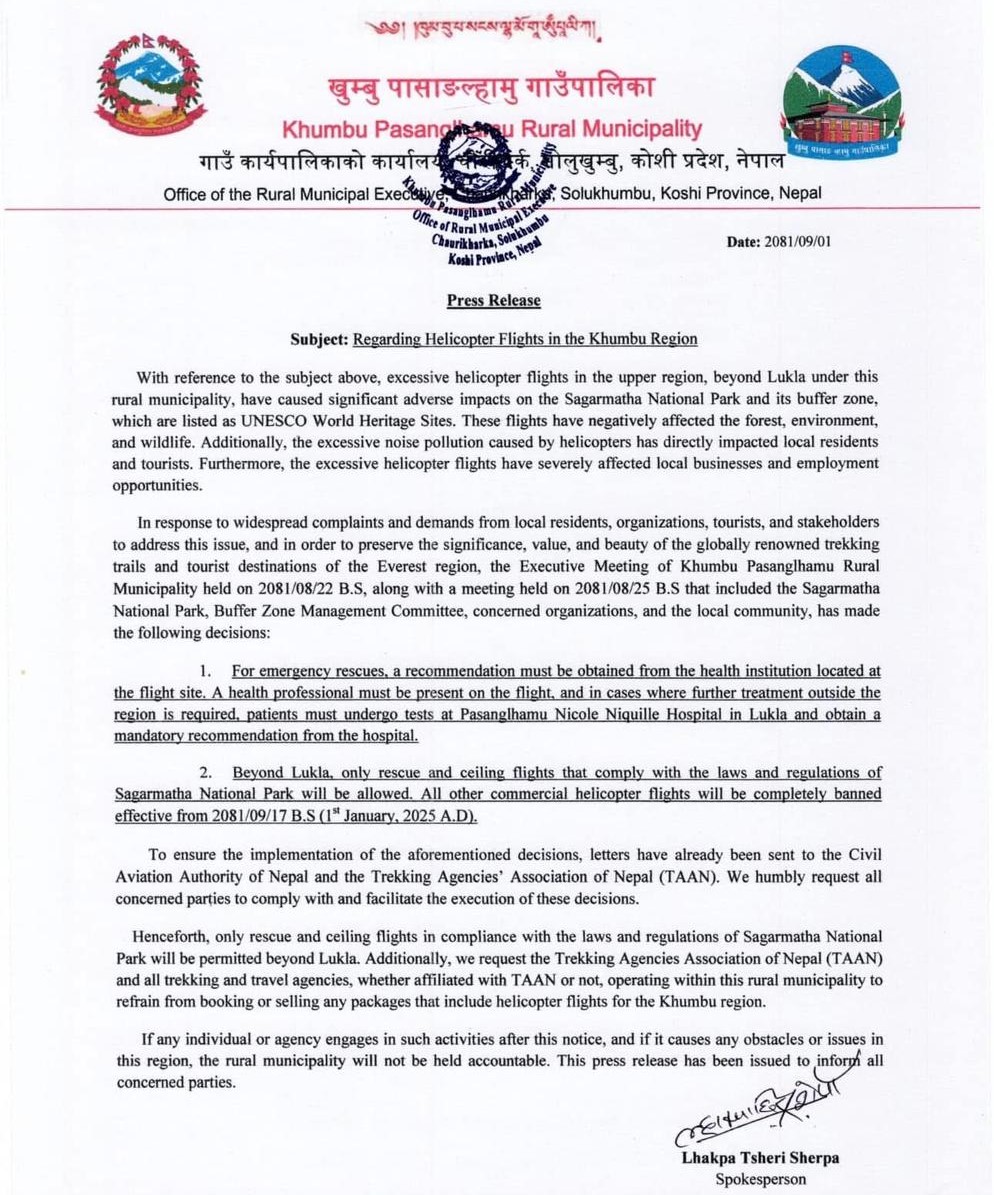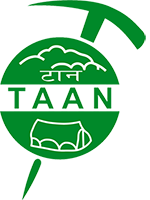
Helicopter flight ban in Everest region

Helicopter flight ban in Everest region
swotah travel
1886
22, 12 2024
The Khumbu Pasanglhamu Rural Municipality, in partnership with Sagarmatha National Park, has decided to ban all commercial helicopter sightseeing flights in the Everest region beyond Lukla. This regulation, set to take effect on January 1, 2025, has ignited a heated debate between conservation priorities and the economic interests of Nepal’s thriving tourism industry.
What’s Changing?
The ban will prohibit all helicopter sightseeing flights within the boundaries of Sagarmatha National Park. While emergency rescue operations and essential transport services will still be allowed under strict regulation, commercial flights catering to sightseeing and luxury transport will no longer be permitted. Additionally, cargo transport above Pangboche, located at an altitude of 3,985 meters, will also be restricted.
For years, helicopter tours have been a popular attraction for tourists who want a quick aerial view of Mount Everest and the surrounding Himalayan landscape. These flights have attracted wealthy travellers seeking a quick yet unforgettable experience in a limited timeframe. However, their increasing frequency—particularly during peak trekking seasons—has raised serious concerns about the environmental and social costs.
Why the Ban?
1. Environmental Degradation
2. Economic Disparities
Helicopter tours have created an imbalance in the local tourism economy. While operators benefit from high-revenue flights, the traditional trekking industry—comprising porters, guides, lodge owners, and other service providers—has suffered. Many trekking routes have seen reduced footfall as tourists increasingly opt for quicker aerial alternatives.
3. Loss of the Trekking Experience
The essence of Everest lies in the journey, not just the destination. Trekking through the Khumbu region allows visitors to immerse themselves in the culture, interact with local communities, and experience the stunning landscapes firsthand. Helicopter tourism, however, undermines this experience, turning the adventure into a fleeting visual spectacle.
Details of the New Regulations
The ban, outlined in a press release issued by the Khumbu Pasanglhamu Rural Municipality, includes specific measures aimed at addressing the challenges posed by helicopter tourism while maintaining essential services:
Emergency and Rescue Flights:
-
- Rescue operations will still be permitted but with stricter oversight.
- Health professionals must be present on the flight, and patients requiring further treatment outside the region must obtain a mandatory recommendation from Pasang Lhamu Nicole Niquille Hospital in Lukla.
Ban on Commercial Flights Beyond Lukla:
-
- Beyond Lukla, only rescue and ceiling flights compliant with Sagarmatha National Park’s laws and regulations will be allowed.
- All other commercial helicopter sightseeing flights will be completely banned starting January 1, 2025.
Prohibition on Cargo Flights:
-
- Cargo transport by helicopter above Pangboche (3,985 meters) will no longer be allowed. This measure seeks to limit unauthorized activities and reduce unnecessary helicopter traffic.
Helicopter Operators and Businesses
While the ban's environmental benefits are clear, its economic implications have sparked controversy. Helicopter tours are a significant revenue generator for Nepal's tourism industry, bringing in millions of rupees each year. Operators argue that the ban will deter high-end tourists, particularly those who lack the time or physical capability to embark on multi-day treks.
A Clash of Authorities
The implementation of the ban has also led to a jurisdictional conflict between the Sagarmatha National Park authorities and Nepal’s Civil Aviation Authority (CAAN). While the park’s administration argues that it has the right to regulate activities within its boundaries, CAAN claims exclusive control over airspace in Nepal. This disagreement has raised questions about the ban's enforceability, with CAAN advising helicopter operators to continue their services.
Alternative to Everest Helicopter Tour
With the upcoming ban on helicopter sightseeing tours in the Everest region, there is a renewed focus on exploring the Himalayas through more immersive, eco-friendly, and culturally enriching travel experiences. For travellers who wish to experience the unparalleled beauty of the Everest region while supporting sustainable tourism practices, we offer thoughtfully designed trekking and adventure packages tailored to provide an unforgettable journey. Here’s a glimpse of our top alternative tours:
1. Everest Base Camp Trek
Duration: 15 Days
Difficulty: Moderate to Challenging
Highlights:
- Walk through traditional Sherpa villages and experience their rich culture.
- Witness breathtaking views of Everest, Lhotse, Nuptse, and Ama Dablam.
- Explore Sagarmatha National Park, a UNESCO World Heritage Site, and its diverse flora and fauna.
- Acclimatize in Namche Bazaar, the vibrant gateway to Everest.
- Visit iconic monasteries, including the Tengboche Monastery, a spiritual haven in the mountains.
Why Choose This?
This classic trekking route offers the chance to fully immerse yourself in the landscape and culture of the Everest region. It’s a fulfilling journey that connects you with the natural and cultural essence of the Himalayas.
2. Gokyo Lakes Trek
Duration: 15 Days
Difficulty: Moderate
Highlights:
- Marvel at the turquoise glacial lakes of Gokyo, surrounded by snow-capped peaks.
- Hike to Gokyo Ri for panoramic views of Everest and the surrounding Himalayan giants.
- Traverse less-crowded trails, offering a peaceful trekking experience.
- Witness the Ngozumpa Glacier, the longest glacier in the Himalayas.
- Engage with local communities in off-the-beaten-path villages.
Why Choose This?
The Gokyo Lakes Trek is ideal for those seeking serenity and spectacular landscapes away from the more popular Everest Base Camp trail.
3. Three Passes Trek
Duration: 20 Days
Difficulty: Challenging
Highlights:
- Cross three high-altitude passes: Renjo La (5,360 m), Cho La (5,420 m), and Kongma La (5,535 m).
- Enjoy awe-inspiring views of Everest, Cho Oyu, Lhotse, and Makalu.
- Combine iconic destinations like Everest Base Camp, Gokyo Lakes, and Kala Patthar into one ultimate adventure.
- Test your endurance and immerse yourself in the rugged beauty of the Everest region.
Why Choose This?
For seasoned trekkers, the Three Passes Trek is the ultimate Himalayan challenge, offering unmatched views and diverse experiences in one comprehensive package.
NEWSLETTER SIGNUP
Sign up to receive our trip ideas and travel offers!
Get updates and Exclusive Offers up to 20% Discount









